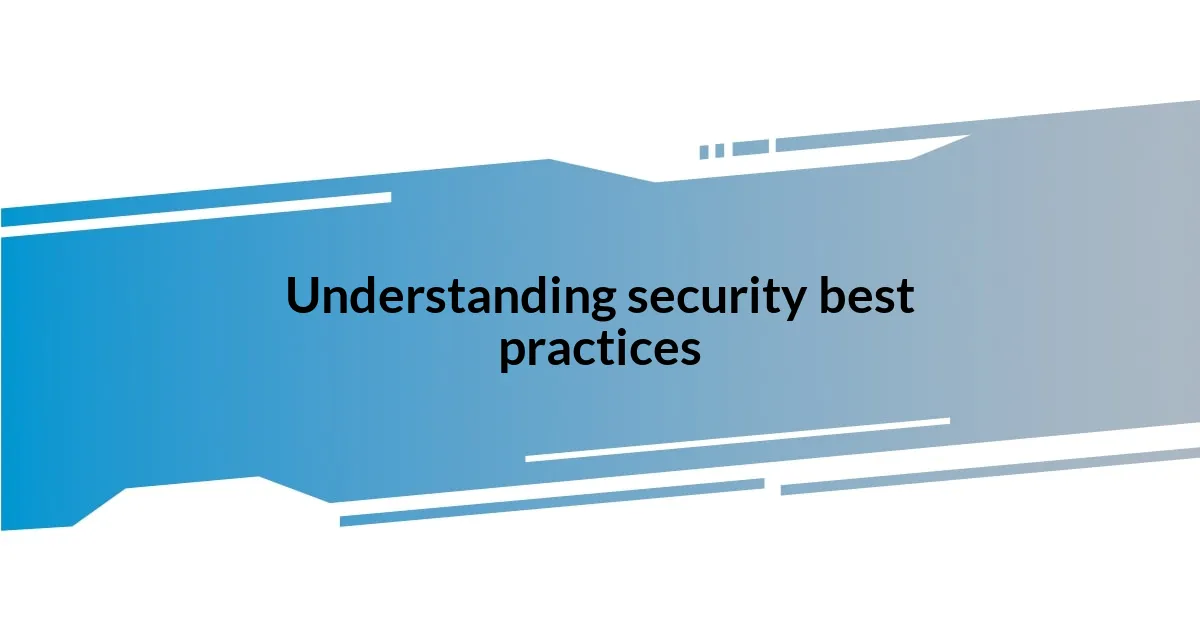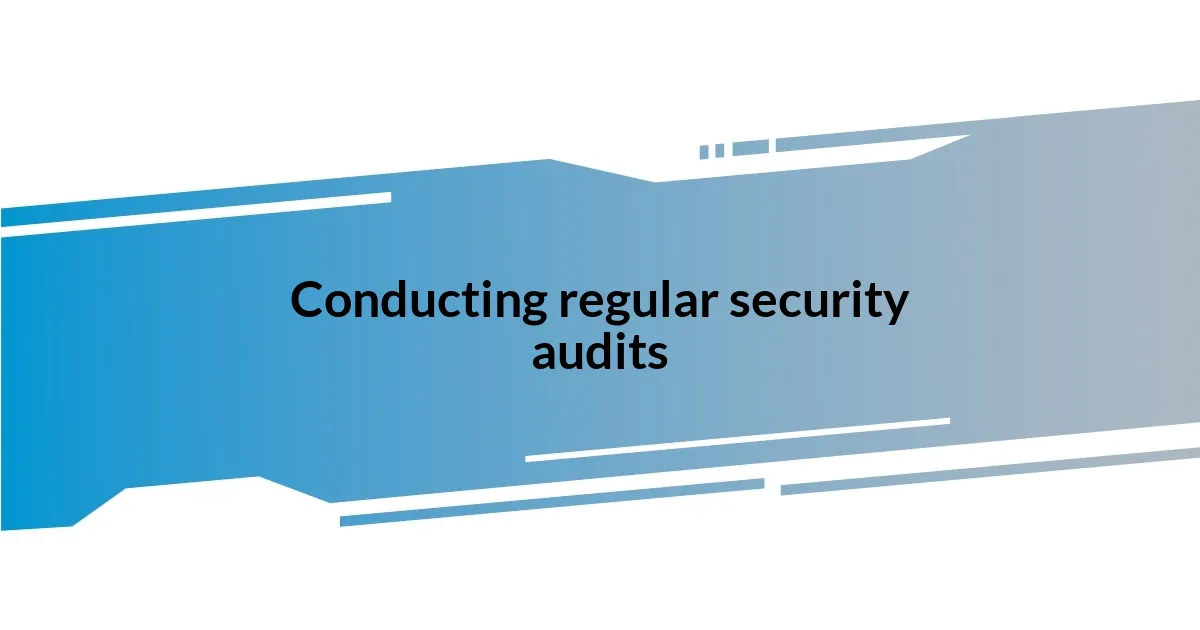Key takeaways:
- Understanding security best practices, including using strong, unique passwords and regular software updates, is crucial in protecting against cyber threats.
- Implementing two-factor authentication (2FA) adds an essential layer of security, significantly reducing the risk of unauthorized access.
- Educating employees about security measures fosters a culture of vigilance and collective responsibility, leading to fewer security incidents.
- Regular security audits uncover vulnerabilities and encourage teamwork, enhancing overall organizational security posture.

Understanding security best practices
Understanding security best practices is essential in today’s digital landscape. I recall a time when I faced a ransomware attack because I overlooked a simple software update. It’s a stark reminder of how even minor lapses in security can have significant consequences.
When considering best practices, I often wonder how many people genuinely understand the importance of using strong, unique passwords. I used to think that one strong password was sufficient until I learned about the risks of password reuse. Now, I rely on a password manager, which not only enhances my security but also alleviates the stress of remembering multiple complex passwords.
Regularly educating myself on security threats has also been a game changer. I remember attending a workshop where they discussed phishing attacks—those sneaky emails that look legitimate but aim to steal your information. It opened my eyes to the tactics employed by cybercriminals and reinforced the need for vigilance. How often do we pause to verify before clicking an unknown link? Making that a habit can dramatically reduce the risk of falling victim to these attacks.

Importance of strong passwords
Using strong passwords is one of the simplest yet most effective ways to protect our digital lives. I still remember the sinking feeling when a friend of mine had their accounts hacked because they’d used the same password across multiple sites. It was a wake-up call, showing just how vulnerable we can be if we don’t take this issue seriously. Strong, unique passwords act as the first line of defense, shielding our sensitive information from potential threats.
I often advise friends and family to think of passwords like keys to our homes. Would you use the same key for your front door and your garage? Probably not. Yet, many of us apply the same logic when it comes to passwords. The key is to combine uppercase and lowercase letters, numbers, and symbols to create a complex password that’s hard to guess but memorable enough for our own use. Trust me, the small effort to create strong passwords can save a world of trouble later.
To put it simply, the security we gain from strong passwords far outweighs the inconvenience of remembering them. When I implemented a password manager, it was a game changer. Suddenly, I could use unique passwords for every account without the mental load. Take a moment to reflect on how many accounts you manage. If you think you’re secure with one strong password, remember that it could unravel quickly.
| Weak Passwords | Strong Passwords |
|---|---|
| Easy to guess | Difficult to crack |
| Increases risk of hacking | Enhances security |
| Often reused across accounts | Unique for every site |
| Simple and short | Complex with symbols, numbers, and mixed cases |

Regular software and system updates
I can’t stress enough the importance of regular software and system updates. I learned this the hard way after a friend’s system was compromised. They missed an update notification, and it allowed a malicious virus to seep into their files. Witnessing their panic made me realize that staying current is a proactive measure every user should embrace. These updates may seem like an inconvenience, but they often contain critical patches that protect your system from vulnerabilities.
Here’s a quick breakdown of why regular updates matter:
- Security patches: Updates often fix vulnerabilities that hackers exploit.
- Improved functionality: Software updates can enhance performance and introduce new features.
- Compatibility: Keeping your system updated ensures that your software works seamlessly with other applications.
- Bug fixes: Addressing glitches can prevent larger issues down the line.
- Enhanced user experience: Updates may refine user interface elements, making software easier to use.
Making it a habit to check for or enable automatic updates is one of the simplest ways to bolster your security protocols. I still remember how relieved I felt knowing my devices were automated to handle updates while I focused on other priorities. It’s an easy step that pays huge dividends in safeguarding your data.

Implementing two-factor authentication
Implementing two-factor authentication (2FA) has been a game changer for me in securing my online accounts. I vividly remember the anxiety I felt after hearing about a data breach at a company I used. It hit home when I realized that just having a strong password wasn’t enough. With 2FA, I now receive a code on my phone or use an authentication app every time I log in, adding an extra layer that can thwart potential hackers. Imagine how much peace of mind that brings!
When I first set up 2FA, it seemed like a minor hassle, yet it was incredibly empowering. There was a slight learning curve, especially when switching devices or dealing with forgotten codes, but trust me, that’s a small price to pay for enhanced security. Now, I can’t imagine logging into my accounts without it. Have you ever thought about how easily a simple password can be stolen? By adding that second step, I feel like I’ve taken a significant proactive measure to protect my digital life.
One of my favorite features of 2FA is how customizable it can be. For instance, I’ve used both SMS codes and an app like Google Authenticator. Each option feels secure, but I love the convenience of having the app since I can access it even when I’m not connected to the network. This flexibility allows me to truly feel in control of my online security. Implementing two-factor authentication isn’t just about reducing risks; it’s about strengthening my overall confidence in managing my digital presence!

Educating employees on security
Educating employees about security is crucial in today’s digital landscape. I remember a time at my previous job when we held a security awareness workshop. It amazed me how many employees were unaware of basic practices, like recognizing phishing emails. By engaging our team in interactive sessions, we transformed their understanding and heightened their vigilance, leading to a remarkable decrease in security incidents. It’s incredible how knowledge can empower individuals to take proactive steps.
During these training sessions, I often noticed a shift in mindset. Employees who initially dismissed security protocols began asking questions, wanting to know more about how they could protect both their personal and company data. That curiosity is what we need! It’s not just about delivering information but fostering a culture where security is everyone’s responsibility. I always think of it as a collective shield—when each person understands and engages in security best practices, we create a much stronger defense together.
Moreover, a follow-up is essential. I recall after our initial training, we implemented regular refresher courses and created a monthly newsletter discussing recent security threats. This initiative encouraged ongoing learning and kept security top of mind. It can be daunting to navigate the complexities of cybersecurity, but I believe that by continually educating employees, we’re not just enhancing our systems—we’re building confidence within our team. Isn’t it reassuring to know that we’re all equipped to contribute to a safer work environment?

Conducting regular security audits
Conducting regular security audits is something I’ve come to view as a cornerstone of a robust security strategy. I still remember the first time I participated in one; it was a bit overwhelming, yet incredibly enlightening. We uncovered vulnerabilities I never knew existed, and it felt like uncovering hidden treasures. It’s more than just ticking a box; it’s about genuinely evaluating our defenses to see what might need improvement.
In my experience, the audit process can reveal both surprising strengths and weaknesses. For instance, during one audit, we discovered that outdated software was still in use, putting sensitive data at risk. That realization was a wake-up call for me. The sense of urgency to implement updates made all the difference in securing our systems. I often wonder how many organizations overlook this vital step at their own peril. Regular audits can have that profound impact by shining light on the dark corners of our security landscape.
An important takeaway from conducting these audits is the teamwork that evolves through the process. I’ve loved how diverse perspectives come together, fostering collaboration. Everyone from IT to management plays a role, and it’s rewarding to see their commitment grow. Have you ever thought about how a simple audit can bolster teamwork and shared responsibility? I truly believe that when every team member feels engaged in security practices, it transforms the entire culture. Regular security audits aren’t just a method—they’re an opportunity for growth and collective awareness.

Responding to security incidents
When a security incident occurs, swift and decisive action is crucial. I can recall a moment when our team faced a data breach; the panic was palpable. We quickly assembled a response team, leveraging predefined protocols. It was fascinating to see how our preparation paid off; having clear steps in place allowed us to contain the threat without causing widespread chaos. What a relief it was to realize that being prepared can mitigate the emotional and operational toll.
I also learned the importance of effective communication during incidents. In that same breach, I watched as our leadership maintained transparency with employees and stakeholders alike. They shared what had happened and the steps we were taking to remedy the situation. This honesty not only built trust but also fostered a sense of collective responsibility. I often ask myself, how can organizations overlook the value of clear communication in a crisis? It can truly make or break the aftermath of a security incident.
Moreover, following the incident, we conducted a thorough analysis to understand what went wrong, which was a transformative experience. Analyzing our response showed us patterns in our weaknesses, guiding our future strategies. In my opinion, every incident presents an opportunity for learning and growth. It’s a chance to revisit what worked well and what didn’t, creating a stronger foundation for the future. Have you ever considered how these moments, while challenging, can ultimately enhance your security posture? They can reshape our approach and redefine our resilience.